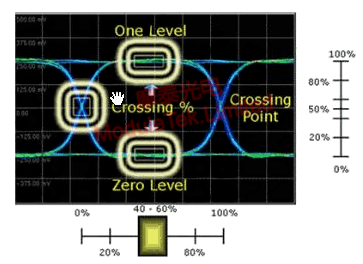Introduction to the main parameters of optical eye pattern
Time: 2019-04-25
1. Formation of eye patterns
An eye pattern is a graph displayed by accumulating a series of digital signals on an oscilloscope, which is visually called an eye pattern due to its shape resembling an open eye.
The generation of eye patterns by an oscilloscope requires measuring a large amount of data before recovering from it. In the oscilloscope measurement eye diagram, after preliminarydata collection, a complete data record can be obtained in its memory. Then, hardware or software is used to restore or extract the clock to obtain a synchronous clock signal. This clock signal is synchronized with the data which in the data record to each bit, and by triggering the restored clock, multiple UI (unit interval, equivalent to one clock cycle) signals captured in the data stream are overlapped, that is, the data waveforms of each bit overlap, and finally an eye pattern is obtained.
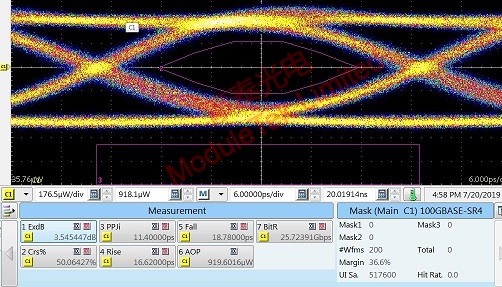
Figure 1 eye pattern
2. Introduction to eye chart structure and main parameters
The main parameters of eye pattern include extinction ratio, jitter, crossover ratio , rising edge time, falling edge time, and margin.
2.1 Extinction ratio
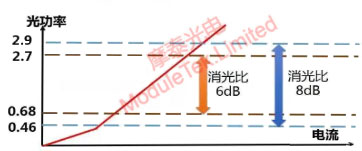
Figure 2 extinction ratio
The extinction ratio is defined as the value of the power of the "1" level over the "0" level in the eye graph. The calculation formula is:. The extinction ratio requirements vary depending on different rates, transmission distances, and laser types. The extinction ratio is a crucial parameter in the measurement of optical communication emission sources, and its size determines the quality of communication signals. The higher the extinction ratio, the better the logical discrimination rate at the receiver end; The lower the extinction ratio, the more susceptiblethe signal is to interference, and the system error rate will increase.
2.2 Jitter
Jitter refers to the horizontal fluctuation of a signal, which refers to the short-term deviation of a signal from its ideal time position at a specific moment. Jitter is timing noise that causes errors in high-speed data transmission lines. Therefore, in the system, minimize this related jitter as much as possible and improve the overall performance of the system. The unit is PS,picosecond. The jitter of the eye pattern can qualitatively reflect the magnitude of signal jitter, and the smaller the jitter, the better the quality of the signal.
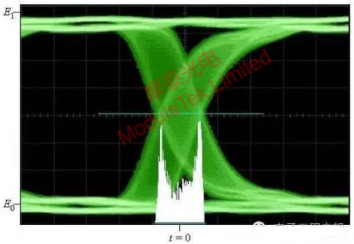
Figure 3 jitter
2.3 Crossover ratio
Figure 4 Crossover ratio
The crossover ratio measures the relationship between the amplitude of the intersection point and the signal "1" and "0" levels, so different cross ratio relationships can transmit different signal levels. It can also be said that the intersection point is the place where two eyes intersect, and its proportion reflects the duty cycle of the signal. The general standard signal has a crossover ratio of 50%, which means that signals "1" and "0" each occupy half of the level. The ability of different signals “1”or“0”to transmit quality varies with the proportion of intersections.
2.4 Rise time
The rise time is the time interval between the 20% to 80% rising edge of the eye graph, reflecting the speed of the signal's rise edge change. It is generally required that the rise time should not exceed 40% of the signal cycle.
Rise time=average rise time (80% time level - average (20% time level), in picoseconds.
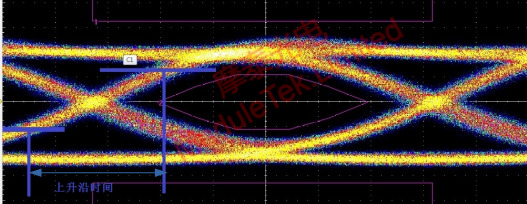
Figure 5 Rise time
2.5 Fall time
The descent time is divided into two horizontal intervals of 80% to 20% along the descent edge of the eye pattern, reflecting the speed of signal descent.
Fall time (ps)=Average rising time (20% time level) - Average (80% time level).
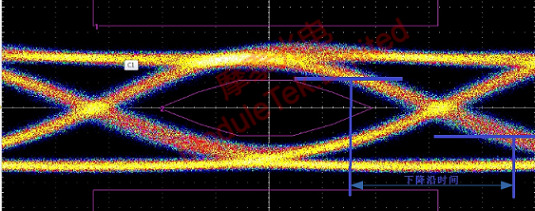
Figure 6 Fall time
2.6 Eye Mask Margin
The edge value of the eye image represents the size at which the edge of the eye image template can be expanded, representing the degree to which the eye image amplitude is opened at the optimal sampling point. The opening degree of a distortionlesseye image should be 100%, but in reality, the shape of the eye image varies from high to low. There are fat and thin, fast and slow, resulting in different margin values. The larger the margin value, the more standardized the eye pattern and the better the signal quality.
Moduletek Limited provides various optical module products, welcome everyone to choose and purchase.
If you have any questions about the above content, you can contact us by Email : web@moduletek.com

 40G/100G Optical Transceivers
40G/100G Optical Transceivers 10G/25G Optical Transceivers
10G/25G Optical Transceivers 155M/622M/2.5G Optical Transceivers
155M/622M/2.5G Optical Transceivers 100M/1G Optical Transceivers
100M/1G Optical Transceivers FC 16G/32G Optical Transceivers
FC 16G/32G Optical Transceivers CWDM/DWDM Optical Transceivers
CWDM/DWDM Optical Transceivers 100M/1G/10G Coppers
100M/1G/10G Coppers Active Cable AOC
Active Cable AOC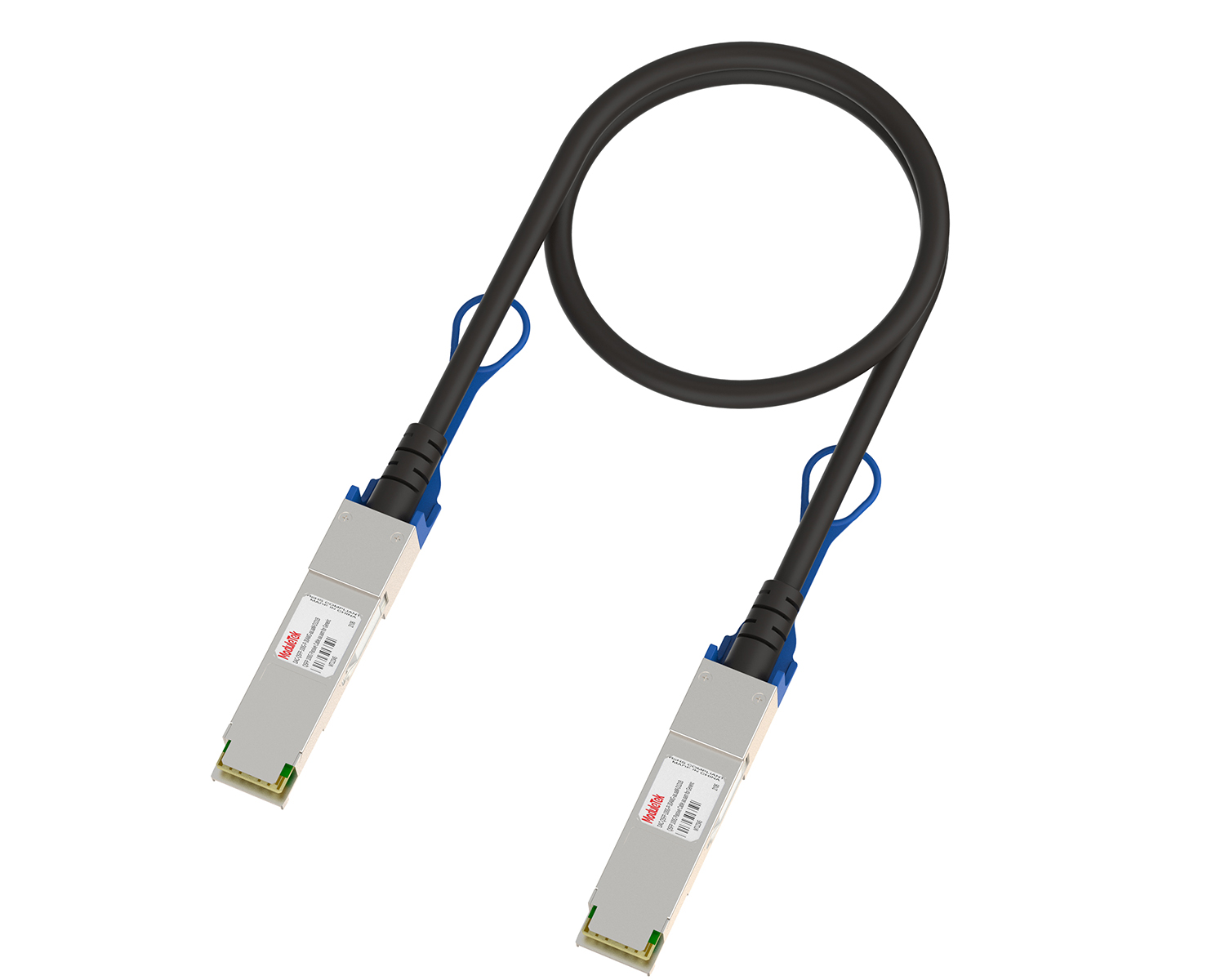 Direct Attach Cable DAC
Direct Attach Cable DAC Regular/MTP-MPO Fiber Patch Cords
Regular/MTP-MPO Fiber Patch Cords MT2011
MT2011 MT2010
MT2010 CodingBox
CodingBox
